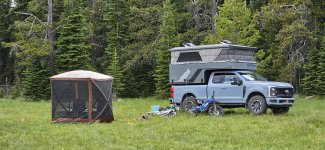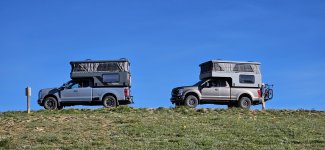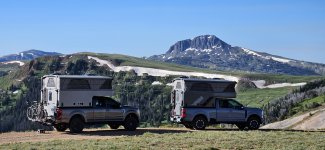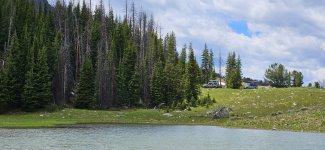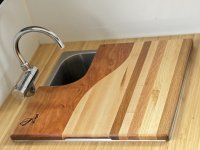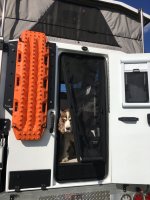You are using an out of date browser. It may not display this or other websites correctly.
You should upgrade or use an alternative browser.
You should upgrade or use an alternative browser.
Supertramp Flagship LT pop-up slide-in pickup camper
- Thread starter Chadx
- Start date
sumnrfam
Retired or just tired….
@knutsCO ,,, great images,, may I ask,, what color is the SuperDuty?,,Hey fellas,
Thought you might be interested in some longish-term operational data from a fellow "tramper" (build #11).
Relevant configuration specs:
2022 F250 SCSB 7.3L gaser with 3.55 gears, 2" front leveling lift and rear Alcan spring packs
35x12.50 Toyo AT3 mounted on 17x9 Method wheels
Typical Axle Weights - 4500 lbs FA / 5000 Lbs RA
2WD front bumper valance
16k total miles since truck was delivered late July 2022
Camper was installed late Aug 2022 and has only been removed (temporarily) for maintenance
This is our second truck camper. Previous was a Northstar Laredo SC on a 2017 F350 SRW CCSB 6.7L diesel which we enjoyed for 2.5 years. See Northstar Laredo SC for relevant configuration details.
Our typical use case is frequent 3-4 day local Colorado trips for hiking, biking and skiing, several western US (Arizona, Utah, Wyoming, etc.) 10 day trips each year, and a longer multi-week XC trip each year to visit family in western NY. Typical speeds for us are 60-65 mph on 2 lane rural highways and posted limits on interstates.
Interestingly, we are seeing similar fuel economy with the F250 Supertramp pop-up vs the F350 Northstar hardside. Both configurations typically achieve(d) 12-14 mpg with a 13.2 mpg long-term average (16k miles) for the F250 gasser and 13.4 mpg long-term average (22k miles) for the F350 diesel. Both trucks have the standard 34 gallon fuel tank, allowing for a comfortable 400 mile range (in the absence of a strong head-wind or significant off-highway driving).
We have used both campers mid-winter in Colorado in single digit above/below 0F ambient temperatures. In fact, we just got back from a skiing trip where we spent a night on Wolf Creek Pass (10,800') during the last storm remnants from the "so called" atmospheric river event that has been pounding California and affecting weather across the desert SW for the past week. The temp dropped to about +5F that night with occasional wind gusts that I estimate were in the 30-40 mph range for several hours during the middle of the night. We awoke to 10' inches of fresh snow on the ground with drifts of 3+ feet in the leigh of the snow mounds surrounding the trailhead parking area at the top of the pass.
I have to say, I am very happy with the comfort and performance of the Supertramp pop-up in these mid-winter conditions. Condensation is almost absent in the Supertramp due to the breathability of the tent material. The only place we have noticed significant condensation is on the vinyl windows and the roof vent fans (to be expected). Previously with the Northstar it was necessary to ventilate to reduce humidity and cut down on condensation on the walls in the cab-over area at night. In similar winter conditions we always had to wipe down the walls in the Northstar bunk area to remove condensation in the morning. Definitely not the case in the Supertramp. To maintain a 50F delta (inside vs outside), I plan for 4 lbs propane/day, so with (2) 11 lb tanks it is possible to go for 4-5 days before refill in mid-winter conditions.
We have (2) 100Ah Battle Born (BB) batteries in our Supertramp. Our experience in cloudy mid-winter conditions suggest that it would be possible to go for 3 days with very limited solar input before recharging with the truck alternators is necessary. From this recent ski trip, I observed we were using about 60 Ah day (including using an electric kettle and Instapot). Typically, on a winter trip like this we only spend 2 nights at any one location, so recharging while driving to the next location has not been a problem. The lowest our battery bank got on this recent trip was 40%. I have removed the Victron DC/DC charger and installed #2 gauge welding cable between the trucks high current battery junction box and the camper bus bars. I control (on/off) the circuit with a high current relay connected to an upfitter switch (Ford factory installed accessory switch). While this set-up not ideal for all end-users, it works well for me since I don't mind monitoring the system while the circuit is energized. Additionally, I have observed that my alternator voltage set point is a very consistent 14.5V, which is an ideal terminal voltage for charging the BB batteries. I really don't have to worry about exceeding the recommended 14.6V maximum charging voltage for the BB camper batteries (BMS disconnect is 14.7V for the BB batteries). With the #2 conductors I typically see about a 60A initial charge rate that tapers as the BB battery voltage rises during charging. Once the BB battery voltage exceeds 14.4V the charge has tapered to less than a few amps. A couple of hours of driving is all that is required to top off the (2) BB batteries starting at 50% discharge.
Cheers,
Ken
Recent Ski Trip (Feb 5-9, 2024) - Overnight stop Penitente Canyon, Colorado BLM
View attachment 819227
View attachment 819228
My two favorite girls...
View attachment 819229
Tomichi Pass (11,962'), Colorado Aug 2022
View attachment 819233
Quartz Creek Meadow, Colorado Sep 2022
View attachment 819230
Bighorn Range, Wyoming Sep 2023
View attachment 819234
Near Hanksville, Utah Oct 2023
View attachment 819235
@knutsCO ,,, great images,, may I ask,, what color is the SuperDuty?,,
His Superduty is the Stone Gray color (brown). It was discontinued, unfortunately, or I may have ordered that color for my '24. For the latest Superduty model, they replaced Stone Gray with the Darkened Bronze Metallic Tricoat. It's @knutsCO's rig, and ours, together in the pics I posted in these links:
https://forum.expeditionportal.com/...up-slide-in-pickup-camper.239844/post-3170482
https://forum.expeditionportal.com/...up-slide-in-pickup-camper.239844/post-3180428
I ended up with the Glacier Gray Metallic Tricoat on our '24, which I love. Glacier Gray replaced Azure Gray which was only on the '23 model year. Ford buys pigments and mixes their own paints and the story is they could not get the pigments they needed for Azure Gray reliably (which had a lot of blue in it) so they replaced it with the new color Glacier Gray. That still has some blue in it but much less blue than the Azure Gray.
Last edited:
sumnrfam
Retired or just tired….
Thanks @Chadx ,, was thinking it was Stone,, but with the different lighting, its hard to tell sometimes,,His Superduty is the Stone Gray color (brown). It was discontinued, unfortunately, or I may have ordered that color for my '24. For the latest Superduty model, they replaced Stone Gray with the Darkened Bronze Metallic Tricoat. It's @knutsCO's rig, and ours, together in the pics I posted in these links:
https://forum.expeditionportal.com/...up-slide-in-pickup-camper.239844/post-3170482
https://forum.expeditionportal.com/...up-slide-in-pickup-camper.239844/post-3180428
I ended up with the Glacier Gray Metallic Tricoat on our '24, which I love. Glacier Gray replaced Azure Gray which was only on the '23 model year. Ford buys pigments and mixes their own paints and the story is they could not get the pigments they needed for Azure Gray reliably (which had a lot of blue in it) so they replaced it with the new color Glacier Gray. That still has some blue in it but much less blue than the Azure Gray.
Thanks,
Fueggia
Selkman
Hello to everyone. If you are still unaware of our small but growing product line, custom made just for your Supertramp Camper, here is our "Lyle's Bugout" PDF. Our product line includes our Custom Magnetic Bug screen and our recently launched Custom sink Cutting board / cheese board, both made to expand and enhance the STC itself. We welcome you to take a look. For those of you that already have our products, please feel free to leave a comment below and thank you all for your support! From one STC to another. Hope to see you all somewhere out there! LyleXP
Attachments
SimplyAnAdventure
Well-known member
I’ll give a free plug for both of these items! I’ll say the screen is an absolute gem and MUST have for a ST. Having it in there doesn’t interfere with anything and it is a much needed upgrade.Hello to everyone. If you are still unaware of our small but growing product line, custom made just for your Supertramp Camper, here is our "Lyle's Bugout" PDF. Our product line includes our Custom Magnetic Bug screen and our recently launched Custom sink Cutting board / cheese board, both made to expand and enhance the STC itself. We welcome you to take a look. For those of you that already have our products, please feel free to leave a comment below and thank you all for your support! From one STC to another. Hope to see you all somewhere out there! LyleXP
The cutting board is also a work of art! I bought it for my wife thinking she would appreciate the bespoke nature of it and what it does to clean up the look inside.
We put a few small stick on clear bumpers on the sink to keep it from rattling or shifting.
Also Mauricio is a most excellent seller to deal with. If you have a ST these are two great products to add to an already great camper.
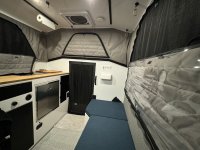
Wow…. Maybe they upgraded this site I can’t usually upload my pics because they are too big.
Fueggia
Selkman
Thank you very much for your kind words and your patronage! It's soooo nice to see our products on another adventurer's rig!!I’ll give a free plug for both of these items! I’ll say the screen is an absolute gem and MUST have for a ST. Having it in there doesn’t interfere with anything and it is a much needed upgrade.
The cutting board is also a work of art! I bought it for my wife thinking she would appreciate the bespoke nature of it and what it does to clean up the look inside.
We put a few small stick on clear bumpers on the sink to keep it from rattling or shifting.
Also Mauricio is a most excellent seller to deal with. If you have a ST these are two great products to add to an already great camper.
View attachment 844317
Wow…. Maybe they upgraded this site I can’t usually upload my pics because they are too big.
Images from trips over the last month.
First two images are of an ATV trip to nearby mountain range in mid-July (left a day early due to black flies and record heat).
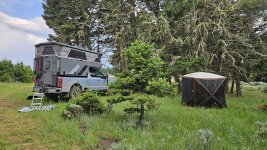
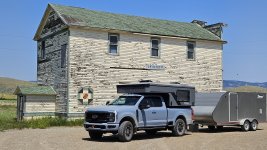
Couple night trip to a different nearby mountain range in late July. Drove the mountain roads for two days.
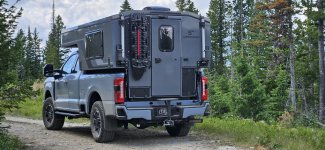
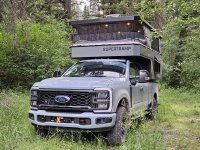
Early August ATV day trip.

Last weekend, few-day trip to a different mountain range amongst the huge Tamaracks. Camp the morning after the first night.
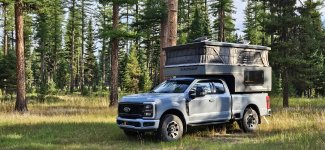
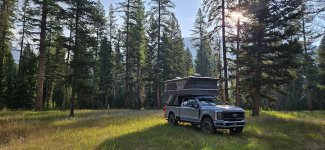
Lunch break on day two. Drove the mountain roads for three days.

Camp spot for the second night. Waiting for Northern Lights (that never materialized) though that was not the reason for the trip.
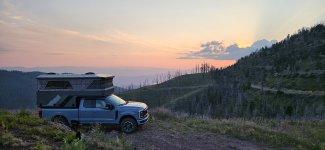
First two images are of an ATV trip to nearby mountain range in mid-July (left a day early due to black flies and record heat).


Couple night trip to a different nearby mountain range in late July. Drove the mountain roads for two days.


Early August ATV day trip.

Last weekend, few-day trip to a different mountain range amongst the huge Tamaracks. Camp the morning after the first night.


Lunch break on day two. Drove the mountain roads for three days.

Camp spot for the second night. Waiting for Northern Lights (that never materialized) though that was not the reason for the trip.

Last edited:
Hey all! New here and looking at the ST campers. This forum has been a great resource.
Looking for some opinions! Side window pros/cons based on your builds?
Thanks!
Jay
Welcome @JFall.
Matter of opinion on this one. I was personally on the fence and was considering not getting the optional large side window. Mrs. Chadx said we were getting it. That was good enough for me! Now that we've had our camper for 1/2 year, I'm really glad that we have the side window.
My original thought process was that there were a lot of windows up in the softtop for views and breeze and that if one was going to sit and lean against that wall, having a window there would hamper that. In real world use in our camper, no one sits there anyway. We have a second Lagun table mount located there and that ended up being the preferred location of the table, so I typically sit over on the shower pan bench seat and wife sits on the front bench seat with the table, and window, between us. When sitting down, having the view out that window has been great and it's available even when the pop top windows are closed (and looking out and/or down rather than just up. It's also proven nice to let in a breeze down low and immediately by us rather than from the higher-up pop-top window.
The door-window is now standard, so you'd still have that for a little bit of light and ventilation if needed. (I believe they can/will still delete the door window upon request).
I can see some use cases where one would not want the window:
- Getting the bunk bed means you cannot have the window.
- If one does a lot of extreme cold camping, having insulated wall there rather than double-pain window could give a slight advantage in maintaining heat, especially if one has the top down during the day and keeps it heated above freezing or even sleeps with the top down.
- Some might mention security, but realistically, lack of window probably doesn't impact that much. We keep our window shade closed while traveling to keep eyes out.
- If you frequent tight, branch-filled trails and pinstripes on acrylic bother you. We have our share on this and previous campers. A three stage acrylic window polish will take out all but the deepest scratches. It is polishing away material, though, so we only do it once a year.
Those are what I come up with off the top of my head.
Fueggia
Selkman
Hi Jay - When we ordered ours (#5) the window options both side and door where not an option - in fact they were not even yet on the spread sheet! We insisted to ST that these two items where indispensable and a must for our build to move forward and true to STC style - they tested, tried, and finally agreed that not only would they install a side window, but that it would be the largest one Tern Overland makes! and a bonus was the door window too. What I am trying to say is that the whole idea of this build, the lifestyle, the adventure, the purpose of ... is to be one with the outdoors. Even in the worst of weather (-18F and ice to Rain and thunder) we have enjoyed our camper in a way that would simply be impossible without these windows! So go ahead and bring nature in!! - If you are boon docking in a city- just pull the blinds down and you are set. Let us know what you decide and welcome to Supertramper!Hey all! New here and looking at the ST campers. This forum has been a great resource.
Looking for some opinions! Side window pros/cons based on your builds?
Thanks!
Jay
Drove down and had a great 3+ hour visit with a fellow Supertramp owner yesterday while they were in the area. I'd posted pics of his rig back in https://forum.expeditionportal.com/...e-in-pickup-camper.239844/page-2#post-3115872
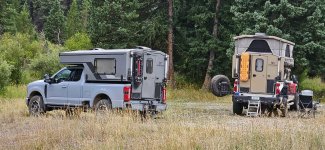
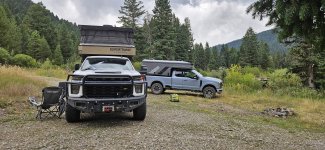




Owners that are using the stock Supertramp mattress, what do you think? Using as is or with mods? Would be good info to share for potential buyers, even though everyone has different preferences. I get asked about it, but we already had a pieced-together mattress that we'd been using in two of our previous campers, so chose to delete the Supertramp mattress from out build.
Our mattress story started three campers ago. We bought a 1.75" eggcrate memory foam topper to put on top of the hard FWC mattress they were using back then. Still no good. Replaced that topper with a 3" memory foam topper. Better, but stock FWC mattress was too firm to be a backer for a memory foam topper. I searched around locally and found a very soft open cell foam at a local store (JoAnn's fabric/hobby lobby type store. Don't recall as it was 7 years ago). That 2" thick, soft, open cell foam was perfect backer to the memory foam topper. It came in 24" wide strips so there were several pieces under our Queen sized topper, but it worked great once in place. We moved that entire setup to the next camper and used it another three years. That stock mattress was stored in a spare bedroom, never used, and sold with that camper. When we ordered the Supertramp, we knew we wouldn't use the stock mattress and didn't want to store it, so we deleted it from our order. We brought our pieced-together mattress down to CO so we'd have something to sleep on when we picked up the Flagship.
I'd been meaning to find one large piece of backer foam to replace the 24" wide strips and find an appropriate mattress cover. Figured we'd bump up from 2" to 3" backer foam at the same time. We ordered a very soft 3" foam from The Foam Factory and also a mattress cover to accommodate what would now be a 6" thick mattress. The backer foam was much too soft. I reached out to The Foam Factory and they agreed I could mail them a little piece of the green 2" foam we liked. They compared to their various foams and found a close match. We ordered a 3" thick piece of that foam in Queen size to back our existing 3" memory foam. Worked out to be the perfect blend for us.
After confirming comfort over a few camping trips, it was time to trim both the memory foam and backer foam to make it fit the unique shape of the Flagship cabover. Not only the two angled front corners (approx. 45% angles) were trimmed, but the entire front of the cabover comes to a point, so a bit of trimming there. The stock queen size was also a bit long and hampered access to the underbed storage because it rubbed a fair bit on the soft top on the way up and down. I shortened the overall mattress length three or four inches and it now lifts up much easier.




While I had the mattress out, it was time to address a small issue with the trim on the under bed storage panel. It was slightly separated when new and the gap increased over time. Supertramp uses a specific version of Sikaflex adhesive (Sikaflex 505) and offered to mail a tube. But, 505 only comes in 10oz cartridges and I only needed a dab, so I had them hold off and said I'd try a fix with some other adhesives. I had a half-used tube of Loctite brand marine epoxy that seems like it was worth a shot. I mixed it up, gooped it in, and strapped it for 24 hours; 2 hours recommended so 24 hours is better, right? Really it just worked better with my schedule. That did the trick. Trim is now staying in place.
The trimmed mattress went back into it's mattress cover and back in the camper. Several trips later, the trim epoxying and trimmed mattress are all working great.
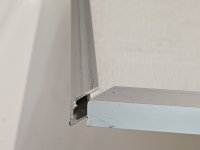
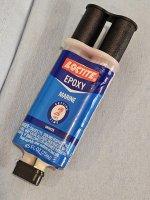
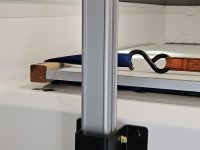
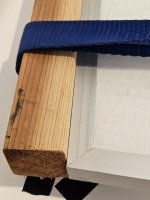
Our mattress story started three campers ago. We bought a 1.75" eggcrate memory foam topper to put on top of the hard FWC mattress they were using back then. Still no good. Replaced that topper with a 3" memory foam topper. Better, but stock FWC mattress was too firm to be a backer for a memory foam topper. I searched around locally and found a very soft open cell foam at a local store (JoAnn's fabric/hobby lobby type store. Don't recall as it was 7 years ago). That 2" thick, soft, open cell foam was perfect backer to the memory foam topper. It came in 24" wide strips so there were several pieces under our Queen sized topper, but it worked great once in place. We moved that entire setup to the next camper and used it another three years. That stock mattress was stored in a spare bedroom, never used, and sold with that camper. When we ordered the Supertramp, we knew we wouldn't use the stock mattress and didn't want to store it, so we deleted it from our order. We brought our pieced-together mattress down to CO so we'd have something to sleep on when we picked up the Flagship.
I'd been meaning to find one large piece of backer foam to replace the 24" wide strips and find an appropriate mattress cover. Figured we'd bump up from 2" to 3" backer foam at the same time. We ordered a very soft 3" foam from The Foam Factory and also a mattress cover to accommodate what would now be a 6" thick mattress. The backer foam was much too soft. I reached out to The Foam Factory and they agreed I could mail them a little piece of the green 2" foam we liked. They compared to their various foams and found a close match. We ordered a 3" thick piece of that foam in Queen size to back our existing 3" memory foam. Worked out to be the perfect blend for us.
After confirming comfort over a few camping trips, it was time to trim both the memory foam and backer foam to make it fit the unique shape of the Flagship cabover. Not only the two angled front corners (approx. 45% angles) were trimmed, but the entire front of the cabover comes to a point, so a bit of trimming there. The stock queen size was also a bit long and hampered access to the underbed storage because it rubbed a fair bit on the soft top on the way up and down. I shortened the overall mattress length three or four inches and it now lifts up much easier.




While I had the mattress out, it was time to address a small issue with the trim on the under bed storage panel. It was slightly separated when new and the gap increased over time. Supertramp uses a specific version of Sikaflex adhesive (Sikaflex 505) and offered to mail a tube. But, 505 only comes in 10oz cartridges and I only needed a dab, so I had them hold off and said I'd try a fix with some other adhesives. I had a half-used tube of Loctite brand marine epoxy that seems like it was worth a shot. I mixed it up, gooped it in, and strapped it for 24 hours; 2 hours recommended so 24 hours is better, right? Really it just worked better with my schedule. That did the trick. Trim is now staying in place.
The trimmed mattress went back into it's mattress cover and back in the camper. Several trips later, the trim epoxying and trimmed mattress are all working great.




Vsgfoster
Continuous Improvement
Appreciate the information. We have tried multiple things including two different toppers and we are currently adding self-inflating, Therma-rest backpacking pads that we already owned. We may end up going your route. What was the foam name that you ended up using from the Foam Factory (how would we identify it to order it from them)?Owners that are using the stock Supertramp mattress, what do you think? Using as is or with mods? Would be good info to share for potential buyers, even though everyone has different preferences. I get asked about it, but we already had a pieced-together mattress that we'd been using in two of our previous campers, so chose to delete the Supertramp mattress from out build.
Our mattress story started three campers ago. We bought a 1.75" eggcrate memory foam topper to put on top of the hard FWC mattress they were using back then. Still no good. Replaced that topper with a 3" memory foam topper. Better, but stock FWC mattress was too firm to be a backer for a memory foam topper. I searched around locally and found a very soft open cell foam at a local store (JoAnn's fabric/hobby lobby type store. Don't recall as it was 7 years ago). That 2" thick, soft, open cell foam was perfect backer to the memory foam topper. It came in 24" wide strips so there were several pieces under our Queen sized topper, but it worked great once in place. We moved that entire setup to the next camper and used it another three years. That stock mattress was stored in a spare bedroom, never used, and sold with that camper. When we ordered the Supertramp, we knew we wouldn't use the stock mattress and didn't want to store it, so we deleted it from our order. We brought our pieced-together mattress down to CO so we'd have something to sleep on when we picked up the Flagship.
I'd been meaning to find one large piece of backer foam to replace the 24" wide strips and find an appropriate mattress cover. Figured we'd bump up from 2" to 3" backer foam at the same time. We ordered a very soft 3" foam from The Foam Factory and also a mattress cover to accommodate what would now be a 6" thick mattress. The backer foam was much too soft. I reached out to The Foam Factory and they agreed I could mail them a little piece of the green 2" foam we liked. They compared to their various foams and found a close match. We ordered a 3" thick piece of that foam in Queen size to back our existing 3" memory foam. Worked out to be the perfect blend for us.
After confirming comfort over a few camping trips, it was time to trim both the memory foam and backer foam to make it fit the unique shape of the Flagship cabover. Not only the two angled front corners (approx. 45% angles) were trimmed, but the entire front of the cabover comes to a point, so a bit of trimming there. The stock queen size was also a bit long and hampered access to the underbed storage because it rubbed a fair bit on the soft top on the way up and down. I shortened the overall mattress length three or four inches and it now lifts up much easier.
View attachment 849902
View attachment 849903
View attachment 849904
View attachment 849912
While I had the mattress out, it was time to address a small issue with the trim on the under bed storage panel. It was slightly separated when new and the gap increased over time. Supertramp uses a specific version of Sikaflex adhesive (Sikaflex 505) and offered to mail a tube. But, 505 only comes in 10oz cartridges and I only needed a dab, so I had them hold off and said I'd try a fix with some other adhesives. I had a half-used tube of Loctite brand marine epoxy that seems like it was worth a shot. I mixed it up, gooped it in, and strapped it for 24 hours; 2 hours recommended so 24 hours is better, right? Really it just worked better with my schedule. That did the trick. Trim is now staying in place.
The trimmed mattress went back into it's mattress cover and back in the camper. Several trips later, the trim epoxying and trimmed mattress are all working great.
View attachment 849906
View attachment 849907
View attachment 849909
View attachment 849911
Appreciate the information. We have tried multiple things including two different toppers and we are currently adding self-inflating, Therma-rest backpacking pads that we already owned. We may end up going your route. What was the foam name that you ended up using from the Foam Factory (how would we identify it to order it from them)?
Hiya Vent. The 3" thick, queen sized foam, that we used under our existing 3" memory foam, was the "HD36-R" foam. The "R" stands for Regular. They also have a "High Quality (HQ)" version that is a bit more dense and "longer lasting and more durable", but it's not a mattress we use every day so figured the Regular version would last plenty long and we wanted the softness to match the sample we had sent and not any firmer. This is the specific product we got. Like most of their foams, and memory foams, you can get it in any thickness and any bed size: https://www.foambymail.com/product/hd36-r-foam-mattress.html
Of note, they sell complete mattresses, various foam and memory foam, and the choices can be a bit overwhelming. And everyone likes a different firmness so short of trying them, it's hard to peg the perfect setup. I didn't mention it before, but when we first got the Flagship, we first went ahead and tried a complete 6" foam/memory foam mattress from Target. They didn't stock them and so they were delivered, but they would take returns at the store if we didn't like it. We did not like it so returned it, then went with what we knew we liked; our existing 3" memory foam with the same density underfoam, and that worked great.
Similar threads
- Replies
- 13
- Views
- 4K
- Replies
- 2
- Views
- 2K
- Replies
- 6
- Views
- 2K
- Replies
- 75
- Views
- 14K

